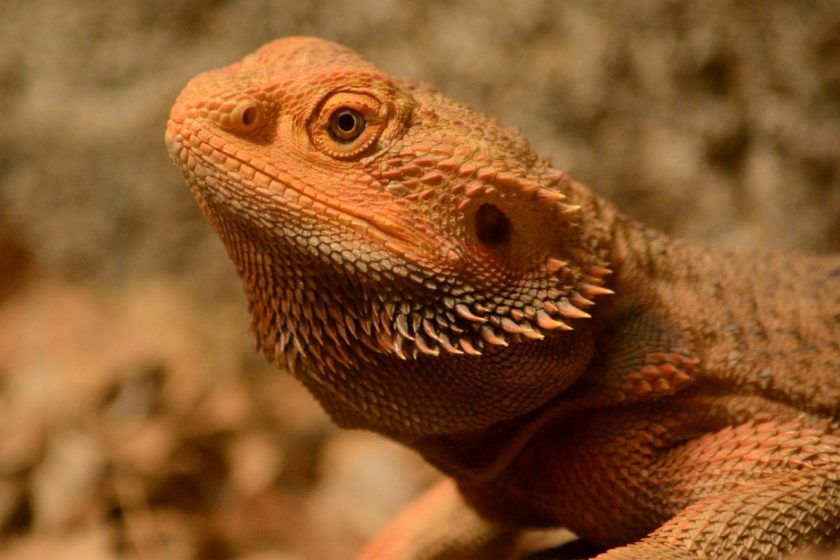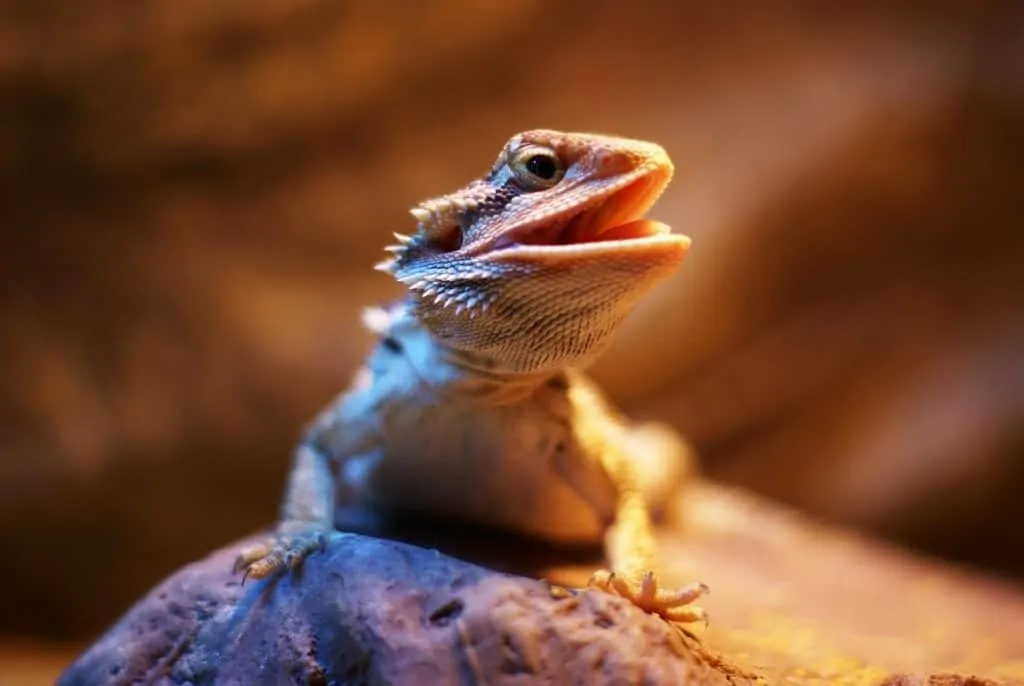Bearded dragons can be great pets but have specific care requirements. One of those requirements is keeping their enclosure at the right temperature. There are a lot of things to consider when heating a bearded dragon’s enclosure:
- What temperature should the enclosure be?
- What is the best heating source?
- Do young bearded dragons have different temperature requirements than adults?
- What will happen if you do not keep your bearded dragon at the right temperature?
- Are there heating devices that you should avoid?
- How long can bearded dragons go without heat?
This article will provide you with the answers to these and other questions.
Can a Bearded Dragon Go a Day Without Heat?
It is not advisable to let bearded dragons go a day without heat. It is recommended that the basking area for your dragon be kept around 110 Fahrenheit (43 Celsius) and the cooler part of the enclosure in the lower 80’s. This is the temperature needed for proper bodily functioning.
The temperature can dip to the lower 50s at night as long as the daytime temperature is as previously indicated. A bearded dragon kept a full day without heat, which could result in digestive issues, leading to further health issues.
Why Do Bearded Dragons Need Heat?
Reptiles are ectothermic, meaning they cannot generate their own body heat. Humans and other mammals are endothermic, which is the ability to generate their own body heat.
Your body temperature does not vary significantly. Whether it is a hot or cold day, your temperature will be about the same. Because bearded dragons cannot regulate their temperature, they depend on their environment to do it. They will bask in the sunshine to warm themselves or find shade to cool themselves.
Without the right temperature, bearded dragons cannot digest their food or perform other vital bodily functions. They become unresponsive. This is why keeping bearded dragons at the right temperature is important.
Heat Sources for Bearded Dragons
There are a variety of heat sources that you can equip your enclosure with. The following is an overview of them:
Basking Lamps
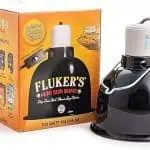
When using basking bulbs, house them in a dome-style fixture that contains a ceramic socket. The dome-style fixture can be suspended over the enclosure. You can also mount the dome-style fixture on a lamp stand.
I recommend avoiding halogen bulbs as they may emit excessive heat unless you use a brand specifically meant for reptiles. Examples of this would be:
- Reptile Systems Infrared Gold Unit (200 W)
- Zoo Med Repti Tuff Splashproof Halogen Lamp
- Arcadia Halogen Heat Lamp
🦎 Find Fluker’s Sun Dome Reptile Lamp on Amazon
Mercury Vapor Lamps
Mercury vapor bulbs offer both heat, UV, and UVB rays. This is a plus because it is an efficient way to provide heat and light. The downside to using them is that a thermostat cannot control them. Because of this, there is the danger of overheating the enclosure. I recommend that you only use them in open-air enclosures.
Dangers of Cold Temperatures for Bearded Dragons
As previously mentioned, bearded dragons are ectothermic. They cannot generate their body heat. A bearded dragon’s body cannot function properly without an external heating source. Cold temperatures cause the metabolism of reptiles to slow down or even come to a halt.
An example of this is the digestive system. Without the proper temperature, bearded dragons cannot properly digest their food. As a result, bacteria can grow, leading to other health problems.
Minimum Temperature for Bearded Dragon Survival
You need to provide your bearded dragons with a temperature gradient. A temperature gradient is a fancy word for the enclosure’s temperature range. The basking area should have the highest temperature while other parts have a lower one.
The following are the temperature gradients for beaded dragons, broken down by age group:
Baby bearded dragons (up to three months old)
Baby dragons rapidly grow, so they consume more energy than adults. Their basking temperature should be 95-110 degrees Fahrenheit (35-43 Celsius). The cooler part of the enclosure should be 80-90 degrees Fahrenheit (26-32 Celsius).
Juvenile bearded dragons (three months to 17 months old)
Juvenile bearded dragons should be kept at a slightly lower temperature than baby dragons. The basking area should be between 95-105 degrees Fahrenheit (35-40.5 Celsius) and a cooler temperature of 80-90 degrees Fahrenheit (26-32 Celsius).
Adult bearded dragons (18 months and up)
Adult bearded dragons can be kept cooler than babies or juveniles. The basking area should be 90-93 degrees (32-33 Celsius). The cooler parts should be 80-90 degrees Fahrenheit (26-32 Celsius).
Alternatives to Keep Your Bearded Dragon Warm
The following are supplemental heating devices for your beard dragon’s enclosure:
Ceramic Heat Emitters
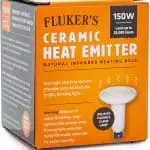
🦎 Find Flukers Heat Emitters on Amazon
Radiant Heat Panels
Radiant heat panels (RHP) work the same way as ceramic heat emitters. However, unlike ceramic heat emitters, RHP can be kept inside the closure as they will maintain the temperature at safe levels. RHP heats objects more than they do the air. They can be used to heat substrate or basking rock.
Heat Pads
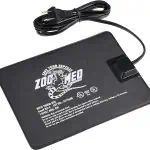
Heat pads will warm the substrate when used on the bottom of the enclosure. Heat pads should only be used in glass enclosures as they can create a fire when used with wooden ones.
🦎 Find Zoomed Reptitherm Undertank Heater on Amazon
Heat Cables
Heat cables can be used as a secondary heating source. They have the advantage over heat pads in that you can be more selective about where heat will be provided. Heat cables are durable, water-resistant, and flexible. Also, you can cut them to size.
🦎 Find Zoo Med Repti Heat Cable on Amazon
Heat Tape
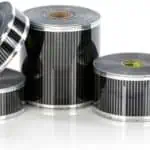
🦎 Find Flexwatt Reptile Heat Tape on Amazon
Heat Rocks
Heat rocks are commonly sold in pet stores but should be avoided. Heat rocks are heating devices with an outer casing resembling natural rock. These devices provide radiant heat. The problem is that bearded dragons have been burned when lying on them.
Maintaining the Proper Temperature
Whether you use heat lamps or alternative methods, I recommend providing continuous temperature monitoring. This is important because you want to be sure the enclosure is at the right temperature.
If the temperature is too high or too low, it can cause health problems or even be fatal. You can monitor the temperature by using thermostats and thermometers.
Thermostats
Thermostats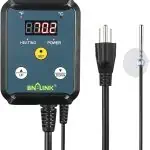
🦎 Find BN-LINK Digital Heat Mat Thermostat Controller for Reptiles on Amazon
Thermometers
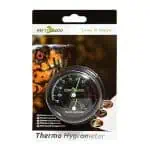
🦎 Find REPTI ZOO Reptile Terrarium Thermometer on Amazon
Keeping Your Beardie Warm During an Outage
If you experience an electrical outage, keep your bearded dragon warm. If the temperature goes below 75 degrees, the following are suggestions:
- Position heat packs or hand warmers near your pet. To avoid having your pet burn themselves, ensure it cannot contact these devices.
- Wrap your beardie in blankets and hold it close to you. It can then share your body heat.
- Place your beardie in your car and turn on the heat.
Managing Heat Lamp Timings
You must provide your bearded dragon with a day and night cycle. They need to experience periods of light and dark. For this reason, I encourage you to purchase a timer for the enclosure’s lighting devices.
In their Australian habitat, bearded dragons enjoy around 14 hours of light in the summer. In winter, there are around 10 hours of sunlight. You can set the timer for these hours. You can use a ceramic heat emitter to heat the enclosure at night if needed.
Bearded Dragons and Night-Time Temperatures
Bearded dragons will do fine at night if the temperature does not go below 59 degrees Fahrenheit (15 degrees Celsius). It is healthier for them to experience a temperature drop as long as they can heat up in the morning.
If you have concerns that the temperature may dip below 59 degrees, provide the enclosure with a ceramic heat emitter.
Take Care!
We hope that you enjoyed this article. Maintaining the proper temperature is critical to keeping bearded dragons healthy. It is important to research each lighting device before using it so that you understand its pros and cons. Remember, some heating devices should only be used as a secondary source. We would enjoy reading your comments. Please share this article.

